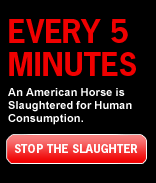by Valerie James-Patton
In December 2008, a resolution called the Horse Industry Policy, was submitted by Wyoming State Rep. Sue Wallis, and former South Dakota State Rep. Dave Sigdestad, to the National Conference of State Legislatures (NCSL), Agriculture and Energy Committee. The NCSL is a non-governmental lobbyist organization which serves the nation's 50 states legislators to advocate and lobby for the interests of states before Congress and federal agencies.
Rep. Sue Wallis is also the Vice Chair of NCSL's Agriculture and Energy Committee. NCSL adopted the Horse Industry Policy resolution on December 11-13, 2008, at the NCSL's Annual Fall Forum in Atlanta, Georgia. The passage of the policy provides the authority for NCSL staff in Washington D.C. to lobby on Capitol Hill and establish the position of the States.
Admitting her personal contempt against animal welfare organizations with this resolution, she stated that "without question, animal agriculture in the US is under siege by radical animal rights organizations—this doesn’t win us the war, but it is a significant skirmish, and we have one more valuable tool in our arsenal."
She also publicly thanked former U.S. Senator Conrad Burns (responsible for the Burns 2004 amendment removing the protection of America's wild horses) who she said was "instrumental" in getting the resolution out of the Agriculture and Energy Committee, and onto the General Session floor for debate and the committee vote.
It was the passage of this resolution, The Horse Industry Policy, that prompted several state resolutions which are opposed to prohibiting horse slaughter, transporting or exporting horses for slaughter, and also seeking to allow the return of the U.S. horse slaughter facilities. The Horse Industry Policy "urges Congress to oppose legislation that would restrict the market, transport, processing, or export of horses, to recognize the need for humane horse processing facilities in the United States, and not to interfere with State efforts to establish facilities in the United States."
Further review into the measures of The Horse Industry Policy reveals that this bill is based upon several completely invalid claims, hypothesized assumptions, and illogical nonsense, often making no sense at all. The resolution claims that the loss of slaughtering horses in the U.S. has severely impacted the markets for horse meat for pet food (horse meat has not been used for pet food in many years), has severely impacted the livestock industry as a whole, (no reason or clarification for statement) has severely reduced the market value of all horses with millions of dollars in indirect costs because of the loss of value of individual animals, (there are no statistics to draw such a conclusion) and has overwhelmed the ability of government and private rescue organizations the ability to deal with the scope of the problem as well as overburdening state and local agencies charged with regulating the transfer, transport, and welfare of horses. (what local agencies are charged with regulating the transfer, transport, and welfare of horses, under what circumstances, and what horses are being referred to, that the loss of slaughtering would affect?) It also states that unwanted horses are abandoned, and the additional pressure on public lands from horses turned out to run wild is only intensifying the over-population, over grazing, and ultimate destruction of the ecosystem, and these horses will compete for adoption with the 32,000 wild horses currently in holding facilities. (what statistics would justify that statement? BLM has not made any claims of large numbers of abandoned horses on public lands destroying the ecosystem. If an abandoned domestic horse was found on public land, BLM would have to comply with rules and regulations and take the horse to proper authorities, and it would not be put up for adoption to compete with wild horses. (whether this statement is just a lack of knowledge or confusion, it is not even a point for consideration...very little of this policy is) A statement in the policy is quoted from the Horse Welfare Coalition; The Horse Welfare Coalition estimates that in excess of 100,000 unwanted horses annually, without any market value whatsoever, will be exposed to potential abandonment and neglect because of the cessation of horse processing in the United States. (hypothesized assumptions do not serve as statistics or fact. There are no statistics or evidence to verify that statement. Also according to Chris Heyde of the Animal Welfare Institute, this coalition was founded and is led by the very same foreign-owned companies that were previously slaughtering our horses here and are now trucking them over the border to Canada and Mexico)
The policy also states that horse processing in the United States is particularly tightly regulated, and the horse is the only animal whose transportation to processing is regulated (see USDA FOIA documentation transport violations to slaughter:
http://www.kaufmanzoning.net/horsemeat/ )
Also in regard to horse exports to Mexico having tripled since the closure of U.S. facilities, it states that equine processing in many foreign facilities is not held to the standards for humane handling and euthanasia required in the United States and often involves practices that would not be tolerated in this country. (because the policy asks Congress not to interfere in the export of horses, it's not clear what the reason for the statement is)
Most all of the state resolutions are based on the wildly exaggerated and inaccurate claims that since the U.S. facilities have closed, horse owners are no longer able to sell their horses, the options for humane disposal or the option to slaughter horses is no longer available to horse owners, which has lead to a crisis of starvation, neglect and abandonment of old, unusable and unwanted horses. But that theory is ridiculous. The slaughter option has always been available to horse owners, proven by U.S.D.A. statistics showing an increase in numbers of U.S. horses slaughtered since the closure of the U.S. facilities. There has been no loss of slaughtered horses to validate any of those claims which are used as the basis for these resolutions. Horses are still purchased for slaughter at auctions nationwide, which proves that the closure of U.S. plants is not responsible for any of the past or current abandoned horse cases, and as well proves that horse slaughter does not prevent or cure abandonment, and is not a solution for those crimes. People who neglect and starve their horses have never been known to take their horses to slaughter, no matter how available the option is. Furthermore, anyone who isn't willing to take a horse to a local auction and abandons it instead, will surely not be willing to take it to a slaughter house, especially one that could be hundreds or thousands of miles away.
Also, many of the stories in the media about abandoned horses were found to be mostly rumor and propaganda. Investigation and research into the many articles that began to appear about abandoned horses, revealed that most all of the articles were untrue and no documentation for these claims could be provided.
Two investigative reports called "Deleting the Fiction", Part 1, & Part 2, can be found at this link under 'The Truth About Abandoned Horses':
http://www.kaufmanzoning.net/horsemeat/
More U.S. horses are being slaughtered now than there were before when the plants were here, and the horses are still purchased at auctions nationwide by the same kill buyers, and delivered to the slaughter house feedlots in Texas, and Montana, where they'll be transported to Canada and Mexico for slaughter. The export to slaughter over both the Canadian and Mexican borders is a common procedure which has been taking place for years.
Despite the claims that U.S. horses are now being exported to Mexico only as a result of the closure of the U.S. facilities, thousands of American horses were being exported to Mexico annually all during the years the plants operated here. The facilities imported and exported horses to whichever facility in either Canada or Mexico that was in need of horses to fill the horse meat demand abroad. The U.S. facilities were also importing Canadian horses when the supply in the U.S was too low to meet their demand. According to USDA statistics, the U.S. plants imported 7,865 horses from Canada for slaughter in the U.S. in 2005, 4,022 imported for slaughter in 2006, and even during the last months the plants operated in 2007, they imported 2,488 Canadian horses for slaughter. If the quantity of horses needed by the U.S. facilities had been locally available, they would not have needed to import horses for slaughter from Canada.
The resolutions are misleading as they suggest that by bringing the horse slaughter facilities back into the U.S., this will stop the export to Mexico for slaughter, where the slaughter process is considered brutally and horrifically inhumane. Instead, these resolutions actually ensure the continued export of our horses, with or without the return of the U.S. facilities. The Horse Industry Policy, clearly "urges Congress to oppose legislation that would restrict the market, transport, processing, or export of horses." Missouri's resolution "urges Congress to oppose any introduced legislation that would restrict the transportation and processing of horses in the US and internationally."
Even though bringing the slaughter facilities back into the U.S. will undoubtedly reduce the numbers of horses exported, just as they were in the past, thousands of horses will still continue to be exported to Canada, as well as to Mexico when those facilities run low.
Up until recently, the media was flooded with articles stating that our horses were now being exported due to animal welfare groups and the ban on horse slaughter. Ironically, they were never exported because of a ban on horse slaughter; they've been exported because there isn't one. That's why one is so badly needed.
Currently other state resolutions are making their way though state legislation processes. North Dakota lawmakers have agreed to a $50,000.00 grant to study the feasibility of a horse slaughtering facility in their state, and Montana's resolution, which includes
legislation to protect against anyone from attempting to prosecute or block the construction or process of a horse slaughter facility, has just passed the state's House, and now moves to the Senate for a vote. Rep. Jim Sacia of Illinois is attempting to overturn the legislation in Illinois that closed Cavel in 2007, and that legislation is currently awaiting the final House vote in Illinois. Other states, such as Arizona, Tennessee, Minnesota, South Dakota, Kansas, and Arkansas have legislation pending. Utah and Wyoming, Rep. Wallis's state, have already passed their resolutions in the state's House and Senate.
Even if these resolutions should pass state House and Senate hearings, there is still federal legislation that has removed funding for USDA inspection of horse meat that they would have to try to overturn before any facility could begin operations. This does give horse welfare advocates a little bit more time to block the assault from Rep. Wallis's NCSL and the state legislators following her lead.
The only way to protect U.S. horses from state legislators with their own personal agendas, such as Rep. Wallis and the NCSL, is to pass a federal ban against the slaughter of horses. The Prevention of Equine Cruelty Act of 2009 (HR 503), needs to be swiftly passed through Congress. Federal legislation will take priority over state legislation, and block the chance for states to try to open horse slaughter houses in the U.S. Without this federal legislation against slaughtering and exporting for slaughter, U.S. horses are doomed.
http://www.opednews.com/articles/Legislation-For-Horse-Slau-by-Valerie-James-Patt-090227-347.html
AQHA Asks Congress to Support Horse Slaughter
14 years ago
















No comments:
Post a Comment